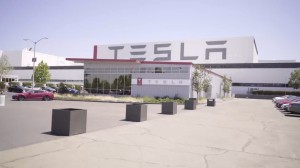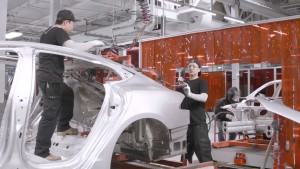
Employees at Tesla's production facility in Fremont, California, complain of poor working conditions and injuries resulting from them.
While Tesla moves to push ahead with production of the Model 3, it is facing challenges inside its factory in Fremont, California, that include an increasingly restless workforce where turnover is high and complaints about on the job injuries are mounting.
The United Auto Workers has launched an organizing drive and pro-union have now filed multiple charges with the National Labor Relations Board, claiming they have been harassed for pro-union activity. Tesla has denied the charges.
But Tesla also has been hit with complaints about working conditions inside the plant, which has also been turned into a giant construction site as the company’s founder pushes ahead with his bold expansion plans. Musk has even talked the Bay Area Rapid Transit authority about building a new station closer to the Fremont factory.
But the injury reports, a symptom of shop floor pressure and old-economy hazards, were given new prominence in a report this week in The Guardian, which noted that ambulances had been called to the Fremont plant more than 100 times since 2014.
“In a phone interview about the conditions at the factory, which employs about 10,000 workers, the Tesla CEO conceded his workers had been ‘having a hard time, working long hours and on hard jobs,’ but said he cared deeply about their health and well-being. His company says its factory safety record has significantly improved over the last year,” the Guardian reported.
(UAW gearing up for organizing battle with Tesla. Find out more, Click Here.)

Tesla's now in the sights of the UAW, which is looking to unionize the company's Fremont plant employees.
“We’re a money-losing company,” Musk added. “This is not some situation where, for example, we are just greedy capitalists who decided to skimp on safety in order to have more profits and dividends and that kind of thing. It’s just a question of how much money we lose. And how do we survive? How do we not die and have everyone lose their jobs?” he also told the Guardian.
The Guardian, however, also interviewed 15 current and former factory workers who described a culture of long hours under intense pressure, sometimes through pain and injury, in order to fulfill the CEO’s ambitious production goals.
Frank Hammer, a former UAW staff member and a veteran of several auto plants around Detroit, noted that Tesla also is the midst of steadily rising production as Tesla builds more vehicles and prepares to build its $35,000 per year Model 3.
“I’m sure everyone in California wants see Tesla succeed. But when you raise production that translates into more pressure for workers on the shop floor,” noted Hammer, who visited the Fremont plant when it was operated by the New United Motor Manufacturing Inc., the General Motors-Toyota joint venture that ended after GM went bankrupt.
“What you have is two very different cultures,” said Harley Shaiken, a professor at the University of California-Berkeley, which has played a role in nurturing the unique culture of San Francisco Bay Area’s Silicon Valley and who has also studied the UAW closely over the years.
“One the one hand you have entrepreneurial, start up culture of Silicon Valley represented by Tesla and on the other hand you have the culture of the factory floor represented by the UAW,” he said. The two have very different perspectives on the world, Shaiken said in an interview.
(Click Here to see what was behind Tesla’s bigger-than-expected Q1 losses.)
Tesla recently announced because it would begin recruiting engineers in Mexico because it couldn’t find enough qualified applicants to staff the Fremont facility. But it also might have been an effort to improve communication with its predominantly Hispanic workforce there.
Meanwhile, Tesla is under significant financial pressure, Tesla losses increased by 40% during the first quarter, but Musk also noted that sales and revenues had grown with production, increasing about 65% from last year’s first quarter to 25,000 vehicles and revenue doubled to $2.7 billion.
The Silicon Valley battery-carmaker reported a loss of $1.33 a share, significantly worse than the 81- to 83-cent loss various tracking firms had Wall Street trackers predicting. The company has turned a quarterly profit – using non-standard accounting – only twice since it went public.
During the conference that stretched for more than an hour as analysts asked questions about production and technology but not about the labor situation in Fremont, Musk said Tesla was on track to build 100,000 Model S and the Model X this year. He also said several times Tesla would be ready to the Model 3 in July. The Model 3 — a compact, electric car that is expected to sell for about $35,000 — is Tesla’s first “mass market” vehicle.
The Model 3 — a compact, electric car that is expected to sell for about $35,000 — is Tesla’s first “mass market” vehicle.
“We’re going to produce 100,000 Model S and Model X,” he said. “All that matters is that will there be demand and I think there will be,” said Musk, who added the Tesla also has started testing the Model on the roads and streets throughout the San Francisco as a prelude to the start of production.
With the launch of the Model 3, Tesla’s goal of building 500,000 vehicles in 2018 will be within reach. The company’s production could reach 1 million units by 2020, Musk said.
(Musk predicts Tesla will build 100K vehicles in 2017. Click Here for the story.)
Even with the million-unit figure, however, seems a stretch since Tesla has no other auto production plan other than Fremont at this point.

I read that there are 10,000 workers in the planting the goal is 500,000 cars. Even if he is only currently making 200,000 now the numbers make no sense. Overtime ? are they rebuilding every car twice. What is the line speed,what is the shift schedule.The reporting on this plant is terrible. It is an assembly plant surely the UAW organizers must start by describing the workplace in detail